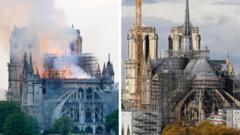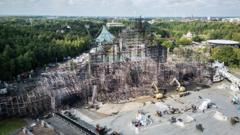On April 15, 2019, a devastating fire brought Notre-Dame de Paris to its knees, causing significant destruction to its storied structure. Yet, as restoration has progressed, the iconic cathedral is set to not only restore but also rejuvenate its architectural splendor. French President Emmanuel Macron recently provided a public glimpse into the profound transformations within. While the restoration seeks to revert the damages of the past, it is equally an opportunity to elaborate on the very essence of what makes Notre-Dame historic.
Reviving Notre-Dame: A Tale of Restoration and Resilience

Reviving Notre-Dame: A Tale of Restoration and Resilience
As Notre-Dame cathedral emerges from the ashes, the intricacies of its restoration reveal a blend of old-world craftsmanship and modern technology.
A key feature of the restoration work is the return of the spire, which collapsed during the fire. The original spire was removed in the 1790s, but its neo-Gothic replacement, designed by architect Eugène Viollet-Le-Duc, fell victim to the flames. The new wooden base showcases a blend of traditional carpentry and modern computerization, combined with Europe’s largest crane and intricate scaffolding for assembly. Adorning the spire is a new gilded cock design that houses relics, including a thorn from the Crown of Thorns and a parchment listing the names of the renovation crew.
The luminosity of the newly cleaned limestone now graces the cathedral’s stonework, with the team meticulously cleaning approximately 40,000 square meters of stone. Using advanced technology, experts sourced replacement stone from northern France and recreated the texture and features of the original masonry, achieving a breathtaking transformation.
The cathedral’s 100-meter wooden roof required an overhaul as none of its ancient timbers survived. Approximately 1,200 oak trees from French forests were selected, guided by detailed architectural studies conducted by Remi Fromont. These trees were treated with traditional craftsmanship to align with the original structural designs of the 13th century.
Many of the sculptural elements, including the famed gargoyles and chimaeras, suffered from water-related damage during firefighting efforts. The meticulous restoration process involved a specialized workshop dedicated to the rigorous cleaning and restoration of these figures. Notably, some were recreated through precise scanning and limestone replacements.
An exciting revival of color is evident within the cathedral's interiors, particularly in the stained-glass windows and chapels. The restoration efforts uncovered rich hues obscured by decades of grime, allowing for a renewed vibrance in the space that harmonizes beautifully with the cleaned limestone.
Additionally, the great organ, integral to the cathedral's acoustics, underwent an extensive cleaning to remove lead monoxide from its pipes. Carefully restored by skilled artisans, the intricate organ is now ready for performance once again, culminating in a praised reinstallation.
The focus on updating the liturgical layout has resulted in a newly crafted bronze altar alongside new chalices. The seating arrangement has changed as well, featuring 1,500 freshly designed wooden chairs for worshippers, along with a new reliquary for the venerated Crown of Thorns.
More than just structural repairs, the restoration has unearthed hidden treasures. Archaeological work has revealed remnants of medieval history beneath the cathedral's floors, including the remains of an ancient rood-screen once dividing sacred spaces from congregants. This rediscovery is anticipated to enrich the cathedral’s narrative even further.
Though the restoration progresses, work is still ongoing, especially in areas still ensconced in scaffolding. Future plans involve redesigning the esplanade and creating a museum at the Hôtel-Dieu hospital nearby.
As Notre-Dame rises from its tragic past, it embodies a broader story of resilience steeped in tradition and innovation, propelling the cathedral into the future while honoring its illustrious history.
The luminosity of the newly cleaned limestone now graces the cathedral’s stonework, with the team meticulously cleaning approximately 40,000 square meters of stone. Using advanced technology, experts sourced replacement stone from northern France and recreated the texture and features of the original masonry, achieving a breathtaking transformation.
The cathedral’s 100-meter wooden roof required an overhaul as none of its ancient timbers survived. Approximately 1,200 oak trees from French forests were selected, guided by detailed architectural studies conducted by Remi Fromont. These trees were treated with traditional craftsmanship to align with the original structural designs of the 13th century.
Many of the sculptural elements, including the famed gargoyles and chimaeras, suffered from water-related damage during firefighting efforts. The meticulous restoration process involved a specialized workshop dedicated to the rigorous cleaning and restoration of these figures. Notably, some were recreated through precise scanning and limestone replacements.
An exciting revival of color is evident within the cathedral's interiors, particularly in the stained-glass windows and chapels. The restoration efforts uncovered rich hues obscured by decades of grime, allowing for a renewed vibrance in the space that harmonizes beautifully with the cleaned limestone.
Additionally, the great organ, integral to the cathedral's acoustics, underwent an extensive cleaning to remove lead monoxide from its pipes. Carefully restored by skilled artisans, the intricate organ is now ready for performance once again, culminating in a praised reinstallation.
The focus on updating the liturgical layout has resulted in a newly crafted bronze altar alongside new chalices. The seating arrangement has changed as well, featuring 1,500 freshly designed wooden chairs for worshippers, along with a new reliquary for the venerated Crown of Thorns.
More than just structural repairs, the restoration has unearthed hidden treasures. Archaeological work has revealed remnants of medieval history beneath the cathedral's floors, including the remains of an ancient rood-screen once dividing sacred spaces from congregants. This rediscovery is anticipated to enrich the cathedral’s narrative even further.
Though the restoration progresses, work is still ongoing, especially in areas still ensconced in scaffolding. Future plans involve redesigning the esplanade and creating a museum at the Hôtel-Dieu hospital nearby.
As Notre-Dame rises from its tragic past, it embodies a broader story of resilience steeped in tradition and innovation, propelling the cathedral into the future while honoring its illustrious history.























